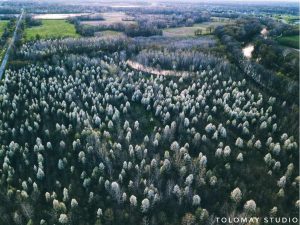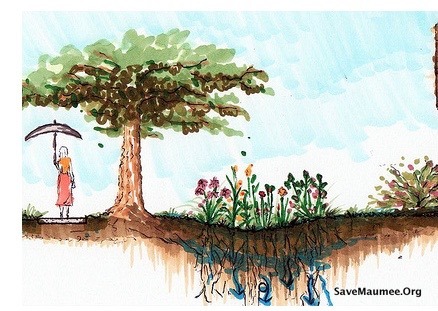Support selective removal of invasive plants
Update: January 23, 2019
Natural Resources Commission adopted a rule that will make dozens of invasive plant species illegal in Indiana pending it pass approval from Governor Eric Holcomb.
“This rule takes 44 highly invasive species and makes it illegal to sell or offer for sale, gift, barter, exchange or distribute them,” said Ellen Jacquart, a member of the Invasive Plant Advisory Committee and president of the Indiana Native Plant Society. Was stated in HoosierTimes.com and nwitimes.com
The rule would ban transporting, selling or soliciting orders for 44 plant species in Indiana. The state spends an estimated $8.6 million managing invasive plants each year, said Megan Abraham, an entomologist with the state.
The Indiana Department of Natural Resources determined that 22 of the invasive plants can be found in nurseries and retail stores, four of which are sold with regularity, Abraham said. She said businesses selling black alder, wintercreeper, amur honeysuckle and common buckthorn should be able to reduce to eliminate their stock while the rule is being reviewed to cause less of an economic impact upon implementation.
The commission’s approval is the beginning of the process that includes a public hearing, the commission’s final adoption, the state attorney general’s approval and the governor’s signature to make it law.
The rule was first drafted four years ago by the Indiana Native Plant and Wildflower Society, according to Ellen Jacquart, the society’s vice president and invasive education chair. She said she’s glad the rule is going through the regulation process but is upset that two very invasive plants are left off the list. The plants are callery pear and Norway maple, tree species popular at nurseries and retail stores.
Abraham said state officials didn’t include the two species because there is too much “in trade currently” to add them to the ban. Jacquart hopes the commission understands the species’ environmental impact outweighs the economic advantage.
SAVE MAUMEE GRASSROOTS ORGANIZATION·TUESDAY, JUNE 26, 2018
Diversity is Earth’s antibiotic. The new forestry technique is to remove the invasive species in wild areas, and the natives will return. One does not even have to plant any other plants (although it of course helps)! To have the natives return, one just needs to remove the plants that do not belong and nature will take care of the rest, unless it has been urbanized, then it takes a bit more work! Humans have introduced these non-natives and it will take humans to help get them under control. Labor and a skilled eye for selective removal is a tremendous asset.
The native species are better adapted to our climate and have longer taproots to live through drought of flood. They have adapted over millions of years and this will help keep them hardy and help them to make it through stress caused by climate changes. Animals in the specific region go hand-in-hand with the plants and have also taken a million years (or so) to adapt and become dependent on the native food sources and habitat these native species of plants provide. Invasive species are not suitable to our local adapted wildlife.
Be selective in your removal though, because different species of plants should be identified and categorized differently…for example:
* Natives – desirable and present previous to European decent and should be protected. Here are some we plant: https://savemaumee.org/native-vegetation/
* Aggressive – present previous to European decent, BUT will aggressively outcompete other more particular native species and not necessarily desirable, but not invasive.
* Naturalized – probably not present to European decent, and have the potential to eventually be invasive in the future, but are not considered invasive and currently have beneficial qualities present currently.
* Exotic – not present previous to European decent and human activity has moved the species here from its indigenous place of orientation.
* Invasive – NOT present previous to European decent, and NOT desirable and SHOULD BE REMOVED in that area as common practice to land management. Invasive species that were not here previous to European descent were introduced by humans. Invasive species outcompete other plants for light, space, water, and nutrients in the soil and some exude chemicals to kill other plants that may be growing near them.
*Prohibited and restricted is also INVASIVE– plants that do direct harm and SHOULD be removed from all of the root to the tip, and all flowers and seeds, and put in a bag and thrown in the trash.
Why are invasive species so bad?
*Competitive advantage over native plants for sunlight, moisture, space and nutrients in the soil, spreading by roots and seed and results in ability to further dominate areas.
* Competes with native plants for pollinators, resulting in fewer seeds set on native species.
- Example: Black swallowwort, (recently identified in Fort Wayne, IN) kills monarch butterflies because it is a close enough relative to our native milkweed that monarch lays eggs on this plants, but the caterpillars die because it is not the right food source.
- Example: Asian Honeysuckle (all 140 non-native species) do not bear fruit that the birds can digest properly. The fruit is carbohydrate-rich and does not provide migrating birds the high-fat content needed for long flights. So native species of birds can starve to death with a full belly. It would be comparable to humans eating lawn-grass – we cannot metabolize lawn-grass for vitamins and nutrients our bodies need.It is suspected that honeysuckles may produce allelopathic chemicals that enter the soil and inhibit the growth of other plants around them.
So the DNR is creating a document of the worst plant offenders and are working to remove these species from store shelves….which is a great idea that Save Maumee supports!
Abigail Frost-King
Save Maumee President & Founder
—————–
TITLE 312 NATURAL RESOURCES COMMISSION
Proposed Rule LSA Document #16-___(F)
Adds 312 IAC 18-3-25 to designate as pests or pathogens, certain invasive terrestrial plants and to prohibit and restrict the sale, distribution, and transport of these invasive terrestrial plants. Effective 30 days after filing with the Publisher.
312 IAC 18-3-25
SECTION 1. 312 IAC 18-3-25 IS ADDED TO READ AS FOLLOWS:
312 IAC 18-3-25 Prohibited and restricted invasive terrestrial plants
Authority: IC 14-10-2-4; IC 14-24-3
Affected: IC 14-24
Sec. 25. (a) The following are prohibited invasive terrestrial plants and are declared pests or pathogens regulated under this section:
(1) Carduus acanthoides ( spiny plumeless thistle).
(2) Phellodendron amurense (Amur cork tree).
(3) Polygonum perfoliatum (mile-a-minute vine).
(4) Vincetoxicum nigrum (black swallow-wort).
(5) Vincetoxicum rossicum (pale swallow-wort).
(b) The following are restricted invasive terrestrial plants and are declared pests or pathogens regulated under this section:
(1) Achyranthes japonica (Japanese chaff flower).
(2) Ailanthus altissima (tree of heaven).
(3) Alliaria petiolata (garlic mustard).
(4) Alnus glutinosa (black alder).
(5) Artemisia vulgaris (mugwort).
(6) Arthraxon hispidus (small carpgrass).
(7) Berberis thunbergii (Japanese barberry).
(8) Carduus nutans (musk thistle).
(9) Celastrus orbiculatus (Asian bittersweet).
(10) Centaurea stoebe (spotted knapweed).
(11) Cirsium vulgare (bull thistle).
(12) Conium maculatum (poison hemlock).
(13) Convolvulus arvensis (field bindweed).
(14) Coronilla varia (crown vetch).
(15) Dioscorea polystachya (oppositifolia) (Chinese yam).
(16) Dipsacus fullonum (common teasel).
(17) Dipsacus laciniatus (cut-leaved teasel).
(18) Elaeagnus umbellata (autumn olive).
(19) Euonymus fortunei (wintercreeper).
(20) Euphorbia esula (leafy spurge).
(21) Frangula alnus (glossy buckthorn).
(22) Humulus japonicus (Japanese hops).
(23) Hesperis matronalis (dame’s rocket).
(24) Lespedeza cuneata (sericea lespedeza).
(25) Lepidium latifolium (pepperweed).
(26) Ligustrum obtusifolium (blunt leaved privet).
(27) Lonicera japonica (Japanese honeysuckle).
(28) Lonicera maacki (Amur honeysuckle).
(29) Lonicera morrowii (Morrow’s honeysuckle).
(30) Lonicera tatarica (Tatarian honeysuckle).
(31) Lonicera x bella (Bell’s honeysuckle).
(32) Microstegium vimineum (Japanese stiltgrass).
(33) Morus alba (white mulberry).
(34) Phalaris arundinacea (reed canarygrass).
(35) Phragmites australis subspecies australis (common reed).
(36) Reynoutria japonica (Japanese knotweed).
(37) Reynoutria sachalinensis (giant knotweed).
(38) Reynoutria x bohemica (Bohemian knotweed).
(39) Rhamnus cathartica (common buckthorn).
(c) This section applies to any part or life stage of the species identified in subsections (a) and (b).
(d) Except as provided in subsection (g):
(1) A person must not possess any species identified in subsection (a).
(2) A property owner who is known to have a species identified in subsection (a) on the owner’s property must take efforts to eliminate this species in such a manner consistent with federal and state law.
(3) A person who grows a plant in identified in subsection (b) at a nursery shall make a good faith effort to destroy it upon closure of the nursery.
(4) A person must not do the following with respect to any species identified in subsection (a) and (b):
(A) Sell, offer or grow for sale, gift, barter, exchange, or distribute a species;
(B) Transport or transfer a species; or
(C) Introduce a species.
(e) As to the species identified in subsection (a), the division may:
(1) Enter a property in which a species is thought to exist, has been detected or has been reported, for the purpose of verifying its presence and the extent to which it has become established.
(2) Gather and record data regarding the location, area infested, habitat, and related data about the site in a division database.
(3) Monitor the site in which a species is found to be established.
(f) The division may regulate an area infested by a species identified in:
(1) Subsection (a) until is it cleared of the identified species to prevent further infestations.
(2) Subsection (a) and (b) to prevent its movement.
(g) Exempted from this section are the following:
(1) A person who possesses a species identified in subsection (a) or (b) under a permit issued by the state entomologist.
(2) A person engaged in a project approved by the state entomologist for the destruction of a species.
(h) A person who discovers a species identified in subsection (a) or (b) may do the following:
(1) Report the discovery to the state entomologist or to the following address:
Department of Natural Resources
Division of Entomology and Plant Pathology
402 West Washington Street, Room W290
Indianapolis, IN 46204
(2) Include in the report provided under subdivision (1):
(A) The location of the discovery, including the name of the county.
(B) The date of the discovery.
(C) Contact information for the person making the report, including telephone number and address.
Black Swallow Wort NRCS document


